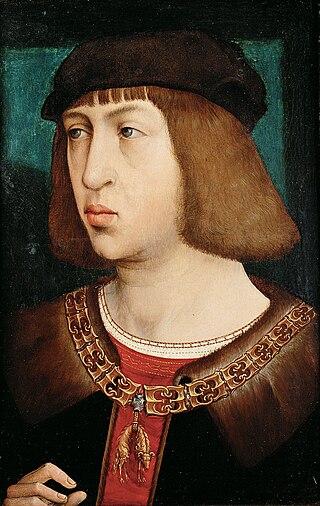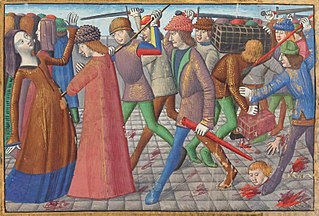
Henry VII was King of England and Lord of Ireland from his seizure of the crown on 22 August 1485 until his death in 1509. He was the first monarch of the House of Tudor.
Year 1496 (MCDXCVI) was a leap year starting on Friday of the Julian calendar.

Perkin Warbeck was a pretender to the English throne claiming to be Richard of Shrewsbury, Duke of York, who was the second son of Edward IV and one of the so-called "Princes in the Tower". Richard, were he alive, would have been the rightful claimant to the throne, assuming that his elder brother Edward V was dead and that he was legitimate—a point that had been previously contested by his uncle, King Richard III.

Margaret of York, also known by marriage as Margaret of Burgundy, was Duchess of Burgundy as the third wife of Charles the Bold and acted as a protector of the Burgundian State after his death. She was a daughter of Richard, 3rd Duke of York, and Cecily Neville, and the sister of two kings of England, Edward IV and Richard III. She was born at Fotheringhay Castle, Northamptonshire, in the Kingdom of England, and she died at Mechelen in the Low Countries.

Philip the Handsome, also called the Fair, was ruler of the Burgundian Netherlands and titular Duke of Burgundy from 1482 to 1506, as well as the first Habsburg King of Castile for a brief time in 1506.

Sir Edward Poynings KG was an English soldier, administrator and diplomat, and Lord Deputy of Ireland under King Henry VII of England.

Philip III the Good ruled as Duke of Burgundy from 1419 until his death. He was a member of a cadet line of the Valois dynasty, to which all 15th-century kings of France belonged. During his reign, the Burgundian State reached the apex of its prosperity and prestige, and became a leading centre of the arts.

Archduchess Margaret of Austria was Governor of the Habsburg Netherlands from 1507 to 1515 and again from 1519 to 1530. She was the first of many female regents in the Netherlands.

The Peace of Étaples was signed on 3 November 1492 in Étaples between Charles VIII of France and Henry VII of England. Charles agreed to end his support for the Yorkist Pretender Perkin Warbeck, in return for being recognised as ruler of the Duchy of Brittany.

The Burgundian party was a political allegiance against France that formed during the latter half of the Hundred Years' War. The term "Burgundians" refers to the supporters of the Duke of Burgundy, John the Fearless, that formed after the assassination of Louis I, Duke of Orléans. Their opposition to the Armagnac party, the supporters of Charles, Duke of Orléans, led to a civil war in the early 15th century, itself part of the larger Hundred Years' War.

Tommaso Portinari was an Italian banker for the Medici bank in Bruges. He was a member of a prominent Florentine family, coming from Portico di Romagna, near Forlì; that family had included Dante's muse, Beatrice Portinari. His father was a Medici branch manager, and after his death in 1421, Tommaso and his orphaned brothers were taken in and raised in the household of Cosimo de Medici. Today he is mainly remembered for two significant commissions of Early Netherlandish paintings.
Events from the 1490s in England.
Events from the 1500s in England.

The Armagnac–Burgundian Civil War was a conflict between two cadet branches of the French royal family – the House of Orléans and the House of Burgundy from 1407 to 1435. It began during a lull in the Hundred Years' War against the English and overlapped with the Western Schism of the papacy.

The dual monarchy of England and France existed during the latter phase of the Hundred Years' War when Charles VII of France and Henry VI of England disputed the succession to the throne of France. It commenced on 21 October 1422 upon the death of King Charles VI of France, who had signed the Treaty of Troyes which gave the French crown to his son-in-law Henry V of England and Henry's heirs. It excluded King Charles's son, the Dauphin Charles, who by right of primogeniture was the heir to the Kingdom of France. Although the Treaty was ratified by the Estates-General of France, the act was a contravention of the French law of succession which decreed that the French crown could not be alienated. Henry VI, son of Henry V, became king of both England and France and was recognized only by the English and Burgundians until 1435 as King Henry II of France. He was crowned King of France on 16 December 1431.
The Treaty of Amiens, signed on 13 April 1423, was a defensive agreement between Burgundy, Brittany, and England during the Hundred Years' War. The English were represented by John, Duke of Bedford, the English regent of France, the Burgundians by Duke Philip the Good himself, and the Bretons by Arthur de Richemont, on behalf of his brother the Duke of Brittany. By the agreement, all three parties acknowledged Henry VI of England as King of France, and agreed to aid each other against the Valois claimant, Charles VII. It also stipulated the marriage of Bedford and Richemont to Burgundy's sisters, in order to cement the alliance.
The Malus Intercursus was a commercial treaty signed in April 1506 by King Henry VII of England and Duke Philip IV of Burgundy. The treaty was signed while Philip was stranded in England, after surviving a shipwreck.

In the period 1482–1492, the cities of the County of Flanders revolted twice against Maximilian of Austria, who ruled the county as regent for his son, Philip the Handsome. Both revolts were ultimately unsuccessful.

The Burgundian State is a concept coined by historians to describe the vast complex of territories that is also referred to as Valois Burgundy.
Jerome, Hieronimo, or Girolamo Frescobaldi was an Italian financier and textile merchant based in Bruges. He supplied luxury goods to the Scottish court and was described as a "very good friend to the King of Scots". The Frescobaldi family and company, based in Florence, were involved in artistic commissions in England and Scotland. Jerome Frescobaldi was involved in the wool trade with Tommaso Portinari and his sons, and marketed spices obtained by Portuguese traders.












